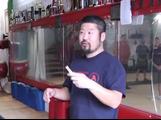In today’s Practical Method practice in Toronto, we covered the triangle, double lock and single lock. Ketong Lin wrote an excellent article on this topic: http://dqstaiji.cn/archives/11907.
Double lock means truly not moving the point in the 3D space. The solid line means that the two points are physically connected, while the dotted line represents that two points are not physical connected (there is as if an invisible line connecting them).
 |
| Figure 1 |
By creating a double lock at point A and C, and forcing point B towards the invisible link, we turn an “A” into an “Arch”. Points A,B,C can present different parts of the body, e.g. Shoulder-Elbow-Hand, Foot-Shoulder-Hand. Right Foot-Dang-Left-Foot. For the Right Foot-Dang-Left-Foot case, this is how we make a dang rounded as supposed to be pointy.
 |
| Figure 2 |
Single Lock means the point is allowed to move along a specific direction, like running on a train track. By turning point C from double lock to single lock, and point B towards the invisible line, point C will shoot out along the A-C line. Let’s use A-B-C for shoulder-elbow-hand as an example, the hand is squeezed out while the shoulder does not move.
 |
| Figure 4 |
Earlier we talked about turning an “A” into an “Arch”. Figure 4 shows the S-Curve (Taiji Symbol). It also shows that our internal actions (color arrows) are different from what the opponent will perceive (black arrows). Often in reality, we are affected by our opponent’s actions, and we lose these internal actions as soon as contact with the opponent is made. We need to train enough such that we can maintain these actions regardless of what happens externally.
Related Video: http://practicalmethod.com/2017/10/triangle/




{ 6 comments… read them below or add one }
Thanks Kelvin, the most triangles i’ve seen used at once.
Thanks for taking the time to show these useful diagrams, Kelvin.
triangles are like bows in other traditional chinese martial arts
Very nice and clear explanation. I like it very much One thing that strikes me is the left shoulder. It’s the only one that has a double lock that also has a direction/intention. It has of course a double function as an end point and a top of a triangle. Does that make the left/front shoulder a special case?
You can look at it in two ways:
1) Only look at two triangles: A-B-C and C-E-G (Ignore C-D-E and E-F-G), this is easier to manage and work on at the beginning.
2) C-E-G is an overlapping triangle on C-D-E and E-F-G. The more we have those little arrows, the more resulting forces can be felt at G by the opponent, the more difficult it is for the opponent to fight against. This is about addition of forces. In much the same way, A-C-E can form a triangle. I didn’t include it as the way those points were lined up in the diagram was very close to a straight line already.
The front shoulder needs a direction or it will pop. The rear kua, being in the center and closer to the ground, generally serves its self. If the overall line of the move is correct it should be there.
Once your shoulder is more capable it can do all sorts of moves without moving the torse with it, which means it really needs something to do or it will go where you don’t want it to.
Before analysing the triangles remember that they conform to the overall taiji principles.
http://practicalmethod.com/2010/12/5-no-online-video-trailer/